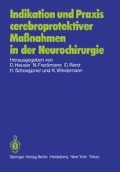Zusammenfassung
Bereits im Jahre 1937 wurde durch Horsley bekanntgemacht, daß Barbiturate den lumbalen Liquordruck vermindern.
Access this chapter
Tax calculation will be finalised at checkout
Purchases are for personal use only
Preview
Unable to display preview. Download preview PDF.
Literatur
Abramson NS, Safar P, Detre K, Kelsey S, Monroe J, Reinmuth O, Snyder J, Mullie A, Hedstrand U, Tammisto T, Lund I, Breivik H, Lind B, Jastremski M (1983) Results of a randomized clinical trial of brain resuscitation with Thiopental. Anesthesiology 59: A101.
Arnfred J, Secher O (1962) Anoxia and barbiturates: tolerance to anoxia in mice influenced by barbiturates. Arch int Pharmacodyn 139: 67.
Astrup J, Skovsted P, Gjerris F, Sørensen HR (1981) Increase in extracellular potassium in the brain during circulatory arrest: effects of hypothermia, lidocaine and thiopental. Anesthesiology 55: 256.
Bleyaert AL, Nemoto EM, Safar P, Stezoski SW, Mickell JJ, Moossy J, Rao GR (1978) Thiopental amelioration of brain damage after global ischemia in monkeys. Anesthesiology 49: 390.
Branston NM, Hope DT, Symon L (1979) Barbiturates in focal ischemia of primate cortex: effects on blood flow distribution, evoked potentials and extracellular potassium. Stroke 10: 647.
Bricolo AP, Glick RP (1981) Barbiturate effects on acute experimental intracranial hypertension. J. Neurosurg. 55: 397.
Brock M, Wiegand H, Zillig C, Zynietz C, Mock P, Dietz H (1976) The effect of dexamethasone on intracranial pressure in patients with supratentorial tumors. In: Pappius HM, Feindel W (eds): Dynamics of brain oedema. Springer, Berlin-Heidelberg-New York 330.
Bruce DA, Raphaely RA, Swerdlow D, Schut L (1980) The effectiveness of iatrogenic barbiturate coma in controlling increased ICP in 61 children. In: Intracranial pressure IV, pp 630–632. Shulman K, Marmarou A, Miller JD, Becker DP, Hochwald GM, Brock M (eds). Springer, Berlin-Heidelberg-New York.
Demopoulos HB, Flamm ES, Seligman ML, Ransohoff J, Jorgensen E (1977) Antioxidant effects of barbiturates in model membranes undergoing free radical damage. Acta neurol scand 56, Suppl 64: 152.
Di Polo R, Beauge R (1979) Physiological role of ATP-driven calcium pump in squid axon. Nature 278: 271.
Feustel PJ, Ingvar MC, Severinghaus JW (1981) Cerebral oxygen availability and blood flow during middle cerebral artery occlusion: Effects of pentobarbital. Stroke 12: 858.
Flamm ES, Demopoulos HB, Seligman ML, Poser RG, Ransohoff J (1978) Free radicals in cerebral ischemia. Stroke 9: 445.
Gisvold SE, Safar P, Hendrickx HHL, Rao G, Moossy J, Alexander H (1984) Thiopental treatment after global brain ischemia in pigtailed monkeys. Anaesthesiology 60: 88.
Harris RA (1981) Ethanol and pentobarbital inhibition of intrasynaptosomal sequestration of calcium. Biochem Pharmacol 30: 3209.
Horsley JS (1937) The intracranial pressure during barbital narcosis. Lancet 1: 141.
Hossmann KA (1982) Treatment of experimental cerebral ischemia. J Cereb Blood Flow Metabol 2: 275.
Langfitt TW, Weinstein JD, Kassell NF (1965) Cerebral vasomotor paralysis produced by intracranial hypertension. Neurology 15: 622.
Marshall LF, Smith RW, Shapiro HM (1979) The outcome with aggressive treatment in severe head injuries. Part II. Acute and chronic barbiturate administration in the management of head injury. J Neurosurg 50: 26.
McIlhany M, Rapaport R, Dunn R, Namazie M, Delilikan A (1983) Althesin in the management of head injuries: a preliminary report. Neurosurgery 12: 77.
Miller JD, Becker DP, Child DC, Carmichael GLM (1984) Barbiturates in the management of severe head injury. Br J Anaesth 1313 P.
Miller JD, Butterworth JF, Gudeman SA, Faulkner JE, Choi SC, Seihorst JB, Harbison JW, Lutz HA, Young HF, Becker DP (1981) Further experience in the management of severe head injury. J Neurosurg 54: 289.
Nilsson B, Nordström CH (1977) Rate of cerebral energy consumption in concussive head injury in the rat. J Neurosurg 47: 274.
Overgaard J, Tweed WA (1983) Cerebral circulation after head injury. J Neurosurg 59: 439.
Prior GJL, Hinds CJ, Williams J, Prior PF (1983) The Use of Etomidate in the management of severe head injury. Intens Care Med 9: 313.
Rea GL, Rockswold GL (1983) Barbiturate therapy in uncontrolled intracranial hypertension. Neurosurgery 12: 401.
Saul TG, Ducker TB (1982) Effect of intracranial pressure monitoring and aggressive treatment on mortality in severe head injury. J Neurosurg 56: 489.
Sehested P, Fedders O, Tange M, Overgaard J (1976) Does barbiturate “monotherapy“ favourably influence brain survival after traumatic coma? In: Jensen HP, Brock M, Klinger M (eds): Dynamics of brain oedema. Springer, Berlin-Heidelberg-New York, 330.
Selman WR, Spetzler F, Roski A, Roessmann U, Crumrine R, Macko R (1982) Barbiturate coma in focal cerebral ischemia. Relationship of protection to timing of therapy. J Neurosurg 56: 685.
Shiu GK, Nemmer JP, Nemoto EM (1983) Reassessment of brain free fatty acid liberation during global ischemia and its attenuation by barbiturate anaesthesia. J. Neurochemistry 40: 880.
Simeone FA, Frazer G, Lawner P (1979) Ischemic brain oedema: comparative effects of barbiturates and hypothermia. Stroke 19: 8.
Smith AL, Marque JJ (1976) Anesthetics and cerebral oedema. Anaesthesiology 45: 64.
Smith DS, Rehncrona S, Siesjö BK (1980) Inhibitory effects of different barbiturates on lipid peroxidation in brain tissue in vitro. Comparison with the effects of promethazine and chlorpromazine. Anesthesiology 53: 180.
Spetzler RF, Selman WR, Roski RA, Bonstelk CB (1982) Cerebral revascularization during barbiturate coma in primates and humans. Surg Neurol 17: 111.
Willow M, Bygrave FL (1982) Effects of pentobarbitone on 45Ca2+ transport by rat brain mitochondria. J. Neurochem 39: 557.
Yasuda H, Shimada O, Nakajima A, Asano T (1981) Cerebral protective effect and radical scavenging action. J Neurochem 37: 934.
Editor information
Editors and Affiliations
Rights and permissions
Copyright information
© 1985 Springer-Verlag Berlin Heidelberg
About this chapter
Cite this chapter
Wiedemann, K., Polarz, H. (1985). Einsatz stoffwechselsenkender Hypnotika beim Schädelhirntrauma. In: Heuser, D., Freckmann, N., Renz, D., Schoeppner, H., Wiedemann, K. (eds) Indikation und Praxis cerebroprotektiver Maßnahmen in der Neurochirurgie. Springer, Berlin, Heidelberg. https://doi.org/10.1007/978-3-642-70783-4_5
Download citation
DOI: https://doi.org/10.1007/978-3-642-70783-4_5
Publisher Name: Springer, Berlin, Heidelberg
Print ISBN: 978-3-540-15886-8
Online ISBN: 978-3-642-70783-4
eBook Packages: Springer Book Archive

